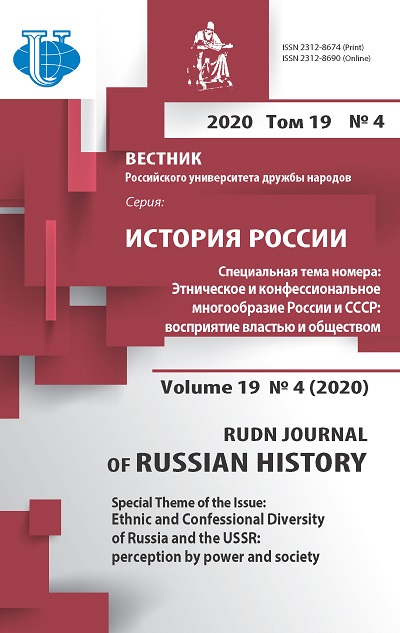Negative Selection: Prohibitions and Restrictions in Red Army Recruitment on Ethnic Grounds during the Great Patriotic War
- Authors: Bezugolny A.Y.1
-
Affiliations:
- Scientific Research Institute of Military History of Military Academy of the General Staff of the Armed Forces of Russia
- Issue: Vol 19, No 4 (2020): Ethnic and confessional diversity of Russia and the USSR: perception by power and society
- Pages: 869-888
- Section: ETHNIC AND CONFESSIONAL DIVERSITY OF RUSSIA AND THE USSR: PERCEPTION BY POWER AND SOCIETY
- URL: https://journals.rudn.ru/russian-history/article/view/25084
- DOI: https://doi.org/10.22363/2312-8674-2020-19-4-869-888
Cite item
Full text / tables, figures
Abstract
The present article continues the research about the role of the ethnic factor in Red Army recruitment during the Great Patriotic War, the first part of which was published in RUDN Journal of Russian History 19, no. 2 (May 2020). This time the focus is on admission restrictions and prohibitions for certain Soviet ethnic groups, as well as on purges from the army due to soldiers’ nationality. The contribution analyzes the major causes and the scale of this phenomenon, as well as the regulatory framework of restrictions and prohibitions and their development during the war. It is established that the reason for such restrictions could be political motives (distrust towards citizens on ethnic grounds), but also the ethno-cultural and linguistic features of conscripts coming from certain nationalities, with the idea that these features prevented their full use in military service. The article analyzes the practice of restrictions on ethnic grounds, including cases when military authorities in the field allowed for significant deviations from the regulatory framework. The scientific novelty of the present research consists in the fact that for the first time the ethnonational aspect of the history of the Red Army during the Great Patriotic War is analyzed with quantitative methods, which made it possible to significantly deepen our understanding of ethnic processes in the Soviet armed forces.
About the authors
Alexey Yu. Bezugolny
Scientific Research Institute of Military History of Military Academy of the General Staff of the Armed Forces of Russia
Author for correspondence.
Email: besu111@yandex.ru
Doktor Istoricheskikh Nauk [Dr. habil. hist.], Leading Researcher at Scientific Research
14, University Av., Moscow, 119330, RussiaReferences
- Bezugol'nyy, A.Yu. “The Ethnic Aspect in Red Army Recruitment During the Great Patriotic War: A Historical and Statistical Review.” RUDN Journal of Russian History 19, no. 2 (2020): 298–319 (in Russian).
- Bezugol'nyy, A.Yu., Bugay, N.F., and Krinko, Ye.F. Gortsy Severnogo Kavkaza v Velikoy Otechestvennoy voyne 1941–1945 gg.: Problemy istorii, istoriografii, istochnikovedeniya. Moscow: ZAO Tsentrpoligraf Publ., 2012 (in Russian).
- Bugay, N.F. Deportatsiya narodov Kryma. Dokumenty, fakty, kommentarii. Moscow: INSAN Publ., 2002 (in Russian).
- Bugay, N.F. L. Beriya – I. Stalinu: «Posle Vashikh ukazaniy provedeno sleduyushcheye…». Moscow: Grif i K Publ., 2011 (in Russian).
- Kakagasanov, G.I., ed. Narody Dagestana v gody Velikoi Otechestvennoi voiny, 1941–1945 gg.: Dokumenty i materialy: (dok. i materialy). Makhachkala: In-t IAE: TsGA RD Publ., 2005 (in Russian).
- Kirsanov, N.A. V boyevom stroyu narodov-brat'yev. Moscow: Mysl' Publ., 1984 (in Russian).
- Ochirov, U.B., and Zayarnyy, S.A. Klyatve ostalis' verny: istoriya formirovaniya i boyevogo puti 110-y Kalmytskoy kavaleriyskoy divizii. Elista: Kalmytskiy nauchnyy tsentr Rossiyskoy akademii nauk Publ., 2018 (in Russian).
- Oshayev, Kh.D. Slovo o polku checheno-ingushskom. Sbornik dokumental'no-khudozhestvennykh proizvedeniy. Nal'chik: El'-Fa Publ., 2004 (in Russian).
- Sukhar', M.Ya. Voyenno-mobilizatsionnaya rabota Sredne-Aziatskogo voyennogo okruga, respublik Sredney Azii i Kazakhstana po podgotovke mobilizatsionnykh rezervov v gody Velikoy Otechestvennoy voyny (1941–1945 gg.). Ashkhabad: [S.n.], 1981 (in Russian).
















